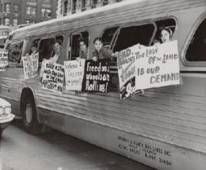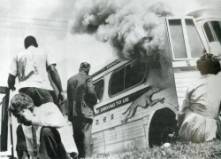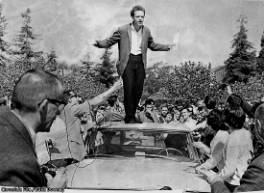 It is important to note that this article is NOT designed to undercut, or delegitimize any efforts made by other groups or persons during the civil rights movement. The purpose of this article is simply to provide a very plausible, less often mentioned possibility to the cause of major youth participation in this movement. Furthermore, no claim in this article exists that the term “teenager” was the beginning of the civil rights movement. This article DOES attempt to show “teenagers” as a catalyst for change, and this change started with Seventeen the magazine.
It is important to note that this article is NOT designed to undercut, or delegitimize any efforts made by other groups or persons during the civil rights movement. The purpose of this article is simply to provide a very plausible, less often mentioned possibility to the cause of major youth participation in this movement. Furthermore, no claim in this article exists that the term “teenager” was the beginning of the civil rights movement. This article DOES attempt to show “teenagers” as a catalyst for change, and this change started with Seventeen the magazine.Seventeen, the magazine, went to great lengths to convince advertisers that teenagers were a marketable group. It is likely they took the approach that teenagers could influence their parents to buy items. Furthermore, teenagers would soon be adults themselves, and it would be to the advantage of advertisers to have already established rapport with teenagers. As Hines said in his book The Rise and Fall of the Teenager:
“From the moment the word “teenager” was coined, anonymously, during World War II, it described both an incipient social problem and an economic opportunity. Teenagers were the forgotten children of the Depression years and the neglected children of the war years. But they were also seen as style setters, those who could help America escape the pessimism of those who had faced the Depression as adults and help America consume itself into prosperity once the war was over.”1
While this viewpoint is certainly accurate it was not inherent in America before Seventeen lobbied advertisers on the behalf of teenagers.
Hines’ choice of the word “consume” at the end of the passage is very deliberate in meaning. Hines believed that people thought that the teen would literally drive the economy out of the depression, and there is a key reason that this was true. Teenagers in the 1940s and 50s did not participate economically during the depression of the 1930s and did not have to provide for a family of their own. Therefore, they were more likely to spend (or at least to encourage their parents to spend) rather than save, and Seventeen Magazine “capitalized”.

Once Seventeen had convinced advertisers teenagers were marketable, the wheels of capitalism began to turn. In capitalism, whenever a new group is found who can move “capital” that group gains power (regardless of how minute that power is). That is to say that they are more capable of influencing trends. This occurs in short because those with capital are trying to make more capital. To this end, products are sold in order to make a profit. It is also important to note that even those of a disadvantaged class could affect trends through their small contribution to the capitalist system. Teenagers were then considered a mainstay way of moving commodities to make more money. So trends in fashion and other areas began to sway toward the “teenager”. This change began to allow teenagers to set mores as a group that were separate from those of their parents.
By the 1950s “teenagers” had gone from influencing fashion (e.g. “bobby sockers”), and consumer products to influencing music, and movies. By 1950 a considerable amount of white youth were listening to black music (i.e. R&B). As Sean Mccollum (Freelance writer and editor of educational and youth oriented publications) wrote in his article 1950 Ad, “In 1951, Alan Freed, a Cleveland disc jockey, heard that a friend's black-oriented record store was full of white teens dancing to R&B records. Freed started playing those tunes on his radio show and emceeing live concerts.” While Freed likely did this to boost viewership and ultimately profits, he also empowered the “teens”, because in general, parents did not welcome this new trend that would become Rock n’ Roll.
Parents tried fervently to stop the trend of teenagers doing something different. They tried to get “teens” to follow traditional values, and felt that rock might be to blame. Parents were so desperate that in some cases they would hold public burnings of the records.4 The FBI also became involved. J Edgar Hoover referred to rock as a “corrupting influence”.4 This shows that adults of the time were using rock as a means to explain the departure of youth from tradition. Mccollum summed up this time by stating, “Across the country, defenders of virtue tried to ban rock and held public record-burnings, only cementing its place as the soundtrack of teen rebellion.”4
So why then didn’t the radio station and record companies stop the rock music? It was just too profitable. By 1958, 70% of record sales were made by “teens”, and they wanted rock.4 Capitalism had decided that the power of the consumer was more important than traditions (not to say that those traditions were right or even necessary). However, it didn’t end there the very message distributed by music and movies began to change.
Frankie Lymon and the Teenagers were a music group of teenagers who made music for teenagers with songs like “I’m Not a Juvenile Delinquent” and “Teenage Love”. It is important to note that this was an interracial group (Hispanic and black); the Teenagers also incorporated a white performer in 1958. In the realm of movies was the iconic Rebel Without a Cause. This movie, starring James Dean, was a departure from the norm. It depicts a troubled youth as the hero in this tragedy. At one point in the movie James Dean trying to explain his feelings states, “If I had one day when I didn't have to be all confused and I didn't have to feel that I was ashamed of everything. If I felt that I belonged someplace. You know?” It would seem that James Dean is speaking to a common theme among the youth of the country at the time. He’s stating the difference of between his generation and that of his parents. He’s not just saying he’s ashamed of things that he’s done, but I believe it’s a commentary of shame for past generations. This movie speaks to the power of youth, and to the parents who are errant in their inability to control these youths. This movie illustrates a shift in paradigm from an adult controlled world to a world in which youth has some power. Both of these are examples of teens moving away from parental guidance, and into guiding themselves and setting their own trends. James Dean character then speaks of “belonging”, and the teens of the 50s found their belonging as young adults (many still being considered teens as it is accustom to be called a teenager until 20 years old) in the Student Non-violent Coordinating Committee and at the University of California-Berkeley, among other schools.

 What was most amazing about their way was the amount of abuse they were willing to take to show the world of the injustices (proof of the strength and power of their movement). During the Freedom rides of 1961 SNCC members were beaten by angry mobs trying to ride interstate buses integrated through the South. They were given little or no protection at times from law enforcement. A bus was firebombed, and the exits to that bus were blocked.5 Yet they rode for freedom. SNCC members also participated in lunch counter sit-ins all over the South. They were regularly arrested, but at times violence broke out and they were ripped from their chairs and beaten.5 All of the brutality seemed to not only bring worldwide attention to inequalities, but also to galvanize the position of the group itself.
What was most amazing about their way was the amount of abuse they were willing to take to show the world of the injustices (proof of the strength and power of their movement). During the Freedom rides of 1961 SNCC members were beaten by angry mobs trying to ride interstate buses integrated through the South. They were given little or no protection at times from law enforcement. A bus was firebombed, and the exits to that bus were blocked.5 Yet they rode for freedom. SNCC members also participated in lunch counter sit-ins all over the South. They were regularly arrested, but at times violence broke out and they were ripped from their chairs and beaten.5 All of the brutality seemed to not only bring worldwide attention to inequalities, but also to galvanize the position of the group itself. Students at the University of California-Berkeley rallied behind free speech rights in 1964. On October 1st when Jack Weinberg was arrested for breaking university policy (he was promoting CORE a group not recognized by the university and refused to show his ID to campus security) students surrounded the police car and proceeded to you it as a “stump” for more than a day. Anyone who wanted a chance to speak was given an opportunity regardless of their viewpoint. This was held up in stark contrast to university policy and was yet another example of youth setting their own standards.
Students at the University of California-Berkeley rallied behind free speech rights in 1964. On October 1st when Jack Weinberg was arrested for breaking university policy (he was promoting CORE a group not recognized by the university and refused to show his ID to campus security) students surrounded the police car and proceeded to you it as a “stump” for more than a day. Anyone who wanted a chance to speak was given an opportunity regardless of their viewpoint. This was held up in stark contrast to university policy and was yet another example of youth setting their own standards.